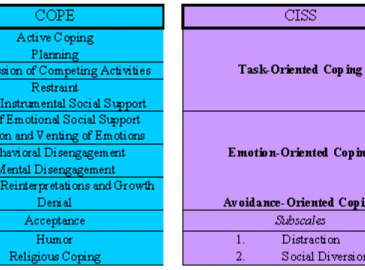When confronted with stressful events, some people actively engage in problem solving techniques while others avoid the problem and hope it will just go away. Still others try to distract themselves from the problem by engaging in another activity. People who use avoidant coping mechanisms might turn to gambling or even substance abuse to escape. Nower, Derevensky and Gupta (2004) hypothesized that the way in which individuals cope with life’s challenges has implications for the development of disordered gambling. This week’s WAGER reviews this article to determine if coping style does matter.
Nower, Derevensky and Gupta (2004) asked professors at five junior colleges in the greater Montreal area to distribute a recruitment letter to students in their classes. This letter explained the purpose of the study and stated that the professors would not be able to read any responses provided by the students. Ninety-seven percent (n = 1,339, aged 17-21) of the recruited students agreed to participate. The participants attended a group session at which the researchers administered a written survey. The survey included instruments to test sensation seeking, impulsivity and gambling activities, as well as the DSM-IV-J to measure pathological gambling and two instruments to measure stress-coping styles. The Coping Inventory of Stressful Situation (CISS) questionnaire measured three dimension of coping: task-oriented coping, emotion-oriented coping, and avoidance-oriented coping. The Coping Orientations to Problems Experienced (COPE) 60-item questionnaire measured preferred coping strategies. Figure 1 lists examples of coping mechanisms taken from the COPE and the CISS questionnaires.
Figure 1. Coping mechanisms found in the COPE and the CISS

Most students (81.3%, n = 1,088) reported gambling during the last year, and a substantial portion (17.9%, n= 240) reported gambling at least once per week during this time frame. As a whole, 4.1% of students met the DSM-IV-J criteria for pathological gambling (i.e., endorsement of 4+ items). Rates of pathological gambling differed significantly by gender: 6.8% of males and 1.7% of females were classified as pathological gamblers, c2 (3, n = 1,339) = 21.55, p < .001. Gamblers and non-gamblers adopted different coping strategies in response to generalized stress, as reported in the questionnaire. On the COPE, non-gamblers were more likely than gamblers to exercise active and planning-oriented coping styles (F(3,1335) = 6.00, p < .001 and F(3,1335) = 8.39, p < .001, respectively). Gamblers were more likely than non-gamblers to engage in avoidance-oriented coping as evidenced by higher scores on the Social Diversion and Distraction subscales of the CISS (F(3, 1335) = 3.32, p = .02, and F(3, 1335) = 7.67, p = .001, respectively), and higher scores on the Denial scale of the COPE (F(3, 1335) = 4.58, p = .01). (1)
However, when the researchers compared the coping styles of disordered gamblers (i.e., problem and pathological gamblers) with non-disordered gamblers (i.e., social gamblers and non-gamblers), important gender differences emerged. Disordered male gamblers had significantly higher scores than non-disordered male gamblers and non-gamblers on most avoidance-oriented coping strategies (e.g., substance use, emotional outlets, distraction, and humor). Male disordered gamblers also had significantly higher scores than male non-gamblers on coping via social encounters, mental disengagement, or denial, and significantly lower scores on planning. No coping style differences distinguished female disordered gamblers from female non-disordered gamblers. Among women, only a few significant coping style differences emerged: non-gamblers used planning and active coping techniques more than social gamblers, and non-gamblers used substances as a coping technique less often than social and problem gamblers used substances.
From the results reported in this study, coping mechanisms appear to have less predictive value for disordered gambling for women than for men. However, the investigators might not have been able to identify subtle coping style differences in women due to the limited statistical power associated with the small number of problem or pathological gamblers (n = 29) in the total sample of women (n = 702). In addition, the study population might not be representative of youth aged 17-21 because college students could have displayed higher rates of active task-oriented coping than the general population.
Nower, Derevensky and Gupta present findings that suggest that among men, disordered gamblers are more likely to engage in avoidance-oriented coping behaviors in response to stress than non-disordered gamblers and non-gamblers. This population might take refuge from their problems in gambling activities instead of actively dealing with the stressful situation. Since the youth in this study are still developing the coping patterns they will use throughout their life (Compas, 1998), more research is needed to evaluate the efficacy of educational interventions that teach active task-oriented coping skills to increase resiliency to disordered gambling. That men’s coping styles tended to discriminate their level of gambling involvement, but women’s did not in this study, suggests that future longitudinal research with greater power to detect female disordered gamblers ought also to address longitudinally these possible differences in the etiology of gambling problems.
Comments on this article can be addressed to Mike Stanton and Rachel Kidman.
Notes
1 Nower, Derevensky and Gupta report only omnibus Chi Square and ANOVA statistics comparing non-gamblers, social gamblers, problem gamblers, and pathological gamblers. However, they report using Bonferroni adjusted pairwise comparisons to control for the increased likelihood of type 1 errors while conducting post-hoc comparisons to test differences between specific groups.
References
Compas, B. E. (1998). An agenda for coping research and theory:basic and applied developmental issues. International Journal of Behavioral Development, 22(2), 231-237.
Nower, L., Derevensky, J. L., & Gupta, R. (2004). The relationship of impulsivity, sensation seeking, coping, and substance use in youth gamblers. Psychology of Addictive Behaviors, 18(1), 49-55.




